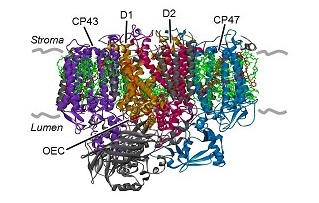Biophysical and biochemical studies of Photosystem II and Photosystem I

In photosynthetic reactions, energy from light is stored as chemical energy. In the oxygenic photosynthesis this process occurs in the thylakoid membranes of green plants, alga and cyanobacteria. The electrons which needed to store the energy in the chemical form are derived from water, the most abundant substance in biosphere. Water is oxidized to dioxygen, electrons and protons by Photosystem II, a multisubunit protein membrane complex. Photosystem II works at extremely high redox potentials and carries out unique proton coupled electron transfer reactions. Photosystem I, another important light driven protein complex continues electron transfer in the thylakoid membrane.
We are interested in the function of these complexes and in the mechanism for the oxidation of water to oxygen. In our experiments we apply different photosynthetic material (cyanobacteria, green algae and plants), various biochemical treatments, illumination procedures and mutants. We using optical, fluorescence and magnetic resonance spectroscopy to study these both Photosystem II and I their redox components.
